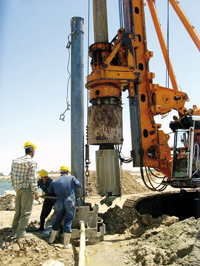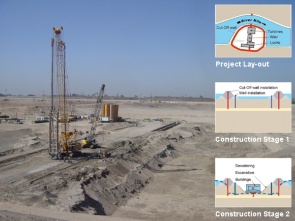Naga Hammadi Barrage, Egypt
The old Naga Hammadi Barrage, one of three structures constructed between 1900 and 1930 along the River Nile in Upper Egypt, is located 130 km north of the city of Luxor and 360 km downstream of the Aswan Dam. The reservoir feeds an agricultural irrigation system of 320,000 ha year-round.
A conceptual study comparing rehabilitation of the existing barrage versus the construction of a new barrage concluded that a new 330 m long sevengate dam, raising the water level up to 8 m, for irrigation should be built along with a ship lock and a 64 MW Run-Of-River hydropower plant. This was considered the most economic alternative for which geologically favourable conditions were identified 3 km downstream of the existing barrage.
The study of the alternatives involved a variety of complex and technically challenging tasks, including 3-D mathematical modelling of groundwater flows, physical hydraulic model tests, optimisation calculations, comparison of flood protection concepts and a comprehensive environmental impact assessment for the project.
To facilitate the construction of the multipurpose barrage, Bauer installed the seepage barrier consisting of a plastic concrete cut-off wall with a depth down to 60 m.
The wall toe is embedded into a silt/clay layer and provides an excellent impervious cut-off, which enabled the excavation of the large temporary construction pit down to 30 m below river level. Bauer installed several water wells for the dewatering of the construction pit. The cut-off wall is approx. 1,800 m long and occupies an area of approx. 243,000 m².
Scope of work:
- Cut-off wall by Bauer Cutter and Clamshell
- Water Well Installation by Bauer BG Drill Rigs






